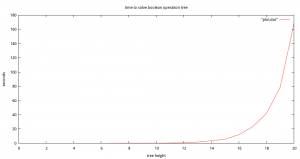Peleándose con P y NP
La época de exámenes es algo curioso, de repente todo lo trivial se vuelve interesante: la trayectoria de las moscas, cualquier cosa que uno se pueda encontrar en la Wikipedia...
En estas me hallaba yo ayer, así que tirando de clásicos acabe "enfrentándome" al problema de P contra NP, y para mi sorpresa creo que di con algo interesante (bueno, eso o entendí algo mal, que es lo más probable :P).
Pero no adelantemos acontecimientos, resulta que escojí un problema NP-completo, satisfacción booleana, y me lié a tirar código, este es el resultado (perdón por la escasez de comentarios):
bool_solve.py: Este es el algoritmo en sí.
1 2 3 4 5 6 7 8 9 10 11 12 13 14 15 16 17 18 19 20 21 22 23 24 25 26 27 28 29 30 31 32 33 34 35 36 37 38 39 40 41 42 43 44 45 46 47 48 49 50 51 52 53 54 55 56 57 58 59 60 61 62 63 64 65 66 67 68 69 70 71 72 73 74 75 76 77 78 79 80 81 82 83 84 85 86 87 88 89 90 91 92 93 94 95 96 97 98 99 100 101 102 103 104 105 106 107 108 109 110 111 112 113 114 115 116 117 118 119 120 121 122 123 124 125 126 127 128 129 130 131 132 133 134 135 136 137 138 139 140 141 142 143 144 145 146 147 148 149 150 151 152 153 154 155 156 157 158 159 160 161 162 163 164 165 166 167 168 169 170 171 172 173 174 175 176 177 178 179 180 181 182 183 184 185 186 187 188 189 190 191 192 193 194 195 196 197 198 199 200 201 202 203 204 205 206 207 208 209 210 211 212 213 214 215 216 217 218 219 | |
bool_test.py: Prueba el código anterior con un ejemplo, y después hace una prueba de tiempos.
1 2 3 4 5 6 7 8 9 10 11 12 13 14 15 16 17 18 19 20 21 22 23 24 25 26 27 28 29 30 31 32 33 34 35 36 37 38 39 40 41 42 43 44 45 46 47 48 49 50 51 52 53 54 55 56 57 58 59 60 61 62 63 64 65 66 67 68 69 70 71 72 73 74 75 76 77 78 79 80 81 82 83 84 85 86 87 88 89 90 91 92 93 94 95 96 97 98 99 100 101 102 103 104 105 106 107 108 109 110 111 112 113 114 115 116 117 118 119 120 121 122 123 124 125 126 127 128 129 130 131 132 133 134 135 136 137 138 139 140 141 142 143 144 145 146 147 148 149 150 151 152 153 154 155 156 157 158 159 160 161 162 | |
Si se lanza el bool_test.py hace sus pruebas y genera un archivo "plot.dat" con los datos de los tiempos, pasados por el Gnuplot sale esto:

Y ahi quedo el tema... eso sí, quedé medio mosca por que no entendía como un algoritmo que solo pasa una vez por cada elemento podía generar tiempos tan claramente exponenciales pero en fin...
Esta mañana me di cuenta de por que era así, el problema era que lo que crecía exponencialmente no era el algoritmo, sinó los árboles que se generan para las pruebas, al ser binarios completos el número de nodos es 2^altura, así que reinterpretando los datos...
1 2 3 4 5 6 7 8 9 10 11 12 | |
Sale algo hermosamente lineal:

En resumen, hay distintas posibilidades:
- La pifié interpretando el problema, y eso no es lo que se supone que había que hacer.
- La pifié en el código y el ejemplo funciona por pura casualidad. (Creo que esto es lo más probable, realmente no se por que demonios funciona :P)